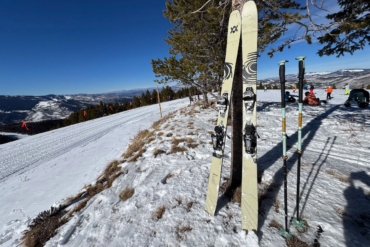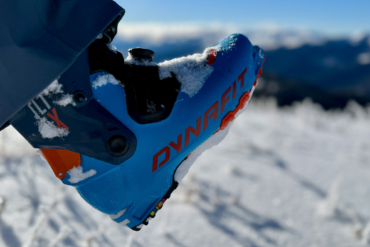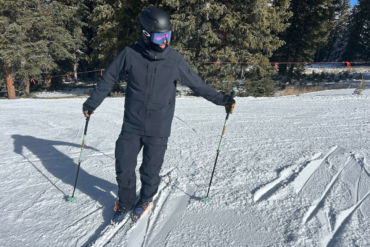The Never Summer Swift has been a favorite of snowboarders who love to surf pow and carve groomers since its release in 2016. This is our multiyear review of both the Swift solid and splitboard.
Never Summer stocks its line with practical, quiver-killing boards for everyday charging: decks like the Shaper Twin for more freestyle-influenced all-mountain riders, the West Bound for freeride powderhounds, and the Proto Type Two — one of my all-time favorite all-mountain boards.
But the Swift ($620) is as close to surfy as the Colorado company gets. The brand built this swallowtail knowing that some riders want one board and one board alone.

In short: I’ve ridden the Never Summer Swift in a variety of conditions, from spring slush and icy hardpack in Colorado to bottomless blower in Utah. I hit natural features on the split and rode the solid on a heli day in Alaska.
My first test on the Swift was when it dropped in 2016 (it had Never Summer’s Original Rocker Camber Profile back then, it now has a Fusion Rocker Camber Profile). I rode the updated shape intermittently over the past couple of years.
I most recently tested the 2020 model, which is the same as last year’s aside from a new topsheet.
Never Summer Swift Snowboard Review

With 20 mm of taper from nose to tail, the Swift has the most aggressively tapered deck in the Never Summer Shaper Series. The nose looks like an enormous grapefruit spoon, minus the serrated edges (although the Vario Power Grip Sidecut does use multiple radii to create extra contact points). The swallowtail boasts a half-moon shape with dual, stubby prongs.
At first glance, the Swift looks like one of the most alternative and pow-specific shapes in the Never Summer lineup. But on paper, the board’s tech specs suggest that the Swift is a standard all-mountain/freeride stick, albeit a slightly wider one. For instance, 20 mm of taper is pretty standard for a pow board with all-mountain capabilities.
The result? The Swift slays deep snow, but it doesn’t ride like a one-trick pow pony on groomers or in variable conditions.
Why I Sized the Swift for Pow
I’m 150, 5’9”, and usually ride a 159 in powder with a full avalanche pack on. For me, the 157 Swift was a dream in deep pow — I set my stance back and never felt under-gunned or overpowered.
For everyday use, I could certainly get away with a 152, but I’d always rather have the extra centimeters for when the weather warnings hit.
Swift Rocker Profile Delivers Peak Pow Performance
Never Summer’s Fusion Rocker Camber profile sandwiches a prominent hump of rocker in between the inserts, while camber pockets add springiness, snap, and security underfoot. The backseat camber zone is more defined and helps to engage the backfoot on technical terrain, while the front camber section flattens out into an extended, floaty nose.
When the board is lying on flat ground (without a rider engaging the camber), only the rocker between the feet is in contact with the ground.
Leaning into an arcing, nose-high pow turn on the Swift, all flaws in your riding momentarily disappear, all external problems in your life cease to exist — there is only the sublime beauty of the moment. At least that’s how it felt for me.
Hot damn, this thing is pure poetry in powder. The rocker profile sinks the swallowtail while the lengthy nose floats like it’s been snorting helium. The beefy 8m sidecut (of the 157 tested) isn’t afraid to draw GS turns down steep, open terrain, as the solid proved in Colorado and Alaska and the split exhibited in Utah (more on the split below).
When dropping smaller cliffs, the Swift’s mid-stiff tail and all-mountain backbone engaged the landing gear with welcome monotony. That said, I probably never dropped anything bigger than 10-12 feet or so.
Railing Carves on Groomers
The Swift is a riot on groomers. Many volume-shifted powder boards (short, wide decks that slice surface area from the tip and tail and pack it around the waist) like the Rossignol Sushi and K2 Cool Bean are naturally slower to transition edge to edge.
The Swift is wider than your typical all-mountain board, but not so much that it’s sluggish. This thing can turn, and the shallow, multi-radius sidecut is aggressive, explosive, and reliable at speed.
Although the Swift’s big-mountain sidecut and carbon-reinforced, mid-stiff core enable supersonic arcs on groomers, the long, flat nose chatters when straight-lining at speed.
Lastly, you wouldn’t expect the Swift to ride switch well — it doesn’t — although it can ride, butter, and land switch better than most swallowtails I’ve tested. Unsurprisingly, the Swift’s nose is catchy when riding switch, although with a little bit of effort you can certainly make it work.
Cons & Concerns
In technical, steep terrain, I want a stiffer board with a more trustworthy tail (i.e., the Never Summer Chairman or the Rossignol XV). However, stiffening or re-configuring the tail would completely ruin the Swift and make it an entirely different board — a sacrifice I would never make.
Personally, this means that the Swift is a piece of my quiver rather than a do-it-all deck. I feel like I could ride it on 50-75% of my days on the mountain and be stoked. If all of those days were powder days, that percentage skyrockets.
My biggest gripes came when navigating the Swift through tight trees. I loved the float the nose offers in deep snow. But in tight, techy trees, especially on icy traverses that ride like luge runs, the wide, long nose was a liability (I recognize that this would be less of an issue if I were on a 152).
Split Decisions: Thoughts on the Never Summer Swift Splitboard

While I’ve had many more days on the solid, I’ve had the opportunity to ride the split a handful of times, and I’m a huge fan. The Swift Splitboard ($1,060) is a powder board by design, and most of the time that I’m splitboarding, surprise, surprise, I’m searching for powder.
That said, as the Stones sang in ’69, “You can’t always get what you want.” I did test the split in variable spring conditions, and it holds up well in hardpack, too. All told, whether you’re jibbing off cornices, harvesting corn, or arcing down couloirs, the Swift Split is a genuine pleasure.
Best-in-Class Durability
Like the Swift solid, the split features Never Summer’s lauded, bombproof construction. This includes a coextruded polymer topsheet (my preference across all brands), a DuraSurf sintered base, sintered P-Tex sidewalls, and aluminum tip and tail protectors (this is a must for a swallowtail, as there are three likely zones for localized delamination).
If you’re ruthless on your gear, the Swift is a smart bet: This beast can handle the inevitable bumps and bruises of backcountry travel.
Uphill Angst
The Swift crushes downhills to be sure, but the main concern is the uphill. There’s a reason why camber-dominant shapes dominate the splitboard market: They perform better on the uphill! Camber allows you to flex and engage your split skis on the way up. Slipping — which can be annoying at best and life-threatening at worst — is much more likely on a rockered split like the Swift.
While the rockered split skis break trail with unrivaled buoyancy, they don’t perform well climbing steep, firm skin tracks, side-hilling wind-buffed aspects, or kick-turning in dicey terrain. Although you can largely remedy this flaw with a pair of splitboard crampons, doing so minimizes glide.
As such, the Swift is best as a second split for deeper days or mellower uptracks, or as a primary split for advanced backcountry travelers who are already skin track senseis or don’t give two hoots about uphill efficiency.
A Swift Summary
For inbounds riding, hike-to terrain, sidecountry missions, cat days, and heli trips, the surfy yet capable Never Summer Swift is a brilliant companion — especially on deeper days. And the Swift Split, while wanting on the uphill, delivers high-performance turns and welcome float on the descent.







